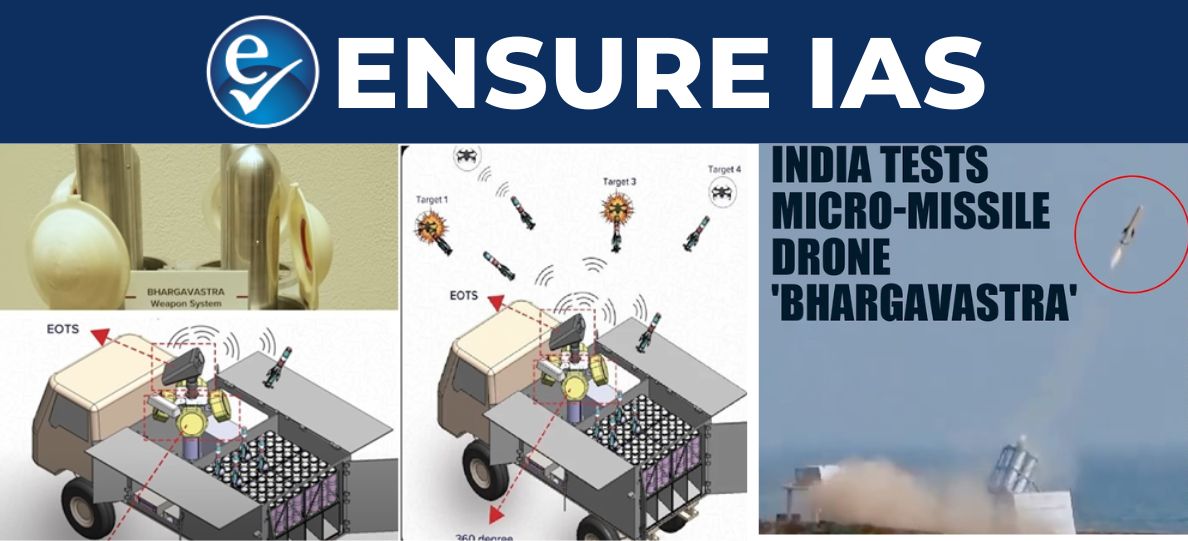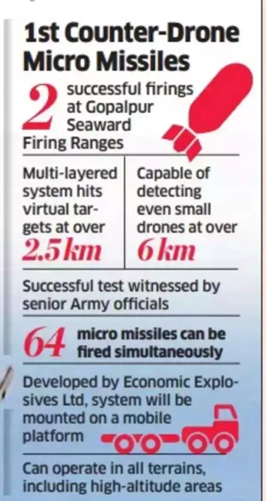- Courses
- GS Full Course 1 Year
- GS Full Course 2 Year
- GS Full Course 3 Year
- GS Full Course Till Selection
- MEP (Mains Enrichment Programme) Data, Facts
- Essay Target – 150+ Marks
- Online Program
- GS Recorded Course
- NCERT- First Ladder
- Polity
- Geography
- Economy
- Ancient, Medieval and Art & Culture AMAC
- Modern India, Post Independence & World History
- Environment
- Governance
- Science & Technology
- International Relations and Internal Security
- Disaster Management
- Ethics
- Current Affairs
- Indian Society and Social Issue
- CSAT
- 5 LAYERED ARJUNA Mentorship
- Public Administration Optional
- ABOUT US
- OUR TOPPERS
- TEST SERIES
- FREE STUDY MATERIAL
- VIDEOS
- CONTACT US
Bhargavastra – India’s First Indigenous Micro-Missile System to Counter Swarm Drone Threats
Bhargavastra – India’s First Indigenous Micro-Missile System to Counter Swarm Drone Threats

1. Bhargavastra, India's first indigenous micro-missile system was successfully tested in January 2025
2. This system was Developed by Economic Explosives Ltd., a subsidiary of Solar Industries India Limited to counter the growing threat of swarm drones.
3. As modern warfare evolves, the use of drone swarms—large groups of small, autonomous drones—has become a significant challenge for conventional defense systems.
4. Bhargavastra aims to address this gap by providing a robust, indigenous solution to neutralize such threats.
Key Features of Bhargavastra
1. Bhargavastra is a fully indigenous system, developed by Indian defense experts.
2. This aligns with the government’s AtmaNirbhar Bharat (Self-Reliant India) initiative, reducing dependency on foreign defense imports and boosting domestic innovation.
3. Technical Capabilities:

- Range: Bhargavastra can engage targets up to 2.5 kilometers away, making it effective against aerial threats.
- Detection: The system can detect drones as small as 6 kilometers away, due to its advanced radar and surveillance technology.
- Micro Munitions: It uses precision-guided micro missiles to neutralize targets with high accuracy.
- Simultaneous Firing: Bhargavastra can fire up to 64 micro missiles at once, making it highly effective against large swarms of drones.
4. The system is designed to be mobile, allowing for rapid deployment across diverse terrains, including high-altitude regions like the Indian borders. This flexibility is crucial for operational effectiveness in challenging environments.
5. Bhargavastra can operate in extreme conditions, such as high-altitude areas, where traditional air defense systems may struggle.
What are Swarm Drones?
1. "Smart War-Fighting Array of Reconfigured Modules", Swarm drones refer to a group of drones that operate together autonomously, using advanced algorithms and communication systems to complete tasks.
2. Unlike individual drones, swarm drones can work in harmony, making them more efficient and resilient.
How Swarm Drones Work:
-
- Swarm drones can perform tasks like surveillance, reconnaissance, and even precision strikes. If one drone fails, the others continue the mission, ensuring operational continuity.
- Advanced Algorithms: These drones rely on sophisticated algorithms, local sensing technologies, and real-time communication to coordinate their actions.
- Recently in the Russia-Ukraine war, drone swarms were deployed for surveillance and attacks.

-
- Control Systems: Swarm drones can operate in 3 ways:
- Pre-programmed paths: Drones follow a predefined flight plan.
- Centralized control: A single control station or drone oversees the entire swarm.
- Distributed control: Drones communicate among themselves and adapt to changing conditions.
- Control Systems: Swarm drones can operate in 3 ways:
Applications of Swarm Drones:
-
- Military Use: Swarm drones are increasingly used for coordinated military operations, including surveillance, reconnaissance, and targeted strikes.
- Disaster Response: In scenarios like wildfires or natural disasters, swarm drones can assess damage, deliver supplies, and even assist in firefighting.
- Enhanced Efficiency: Swarm technology allows multiple drones to perform complex tasks simultaneously, such as covering large areas or conducting detailed assessments.
- Robustness: The distributed nature of swarm drones makes them resilient, as the failure of one drone does not compromise the entire mission.
What are the Government initiatives to promote the drone ecosystem ?India has been actively promoting the development and adoption of drone technology through various government initiatives:
|
|
Also Read |
|
Public Administration Optional |
UPSC Daily Current Affairs |
UPSC Monthly Mgazine |
Question Answer Practice For UPSC |
Free MCQs for UPSC Prelims |
UPSC Test Series |
ENSURE IAS NOTES |
Our Booklist |




